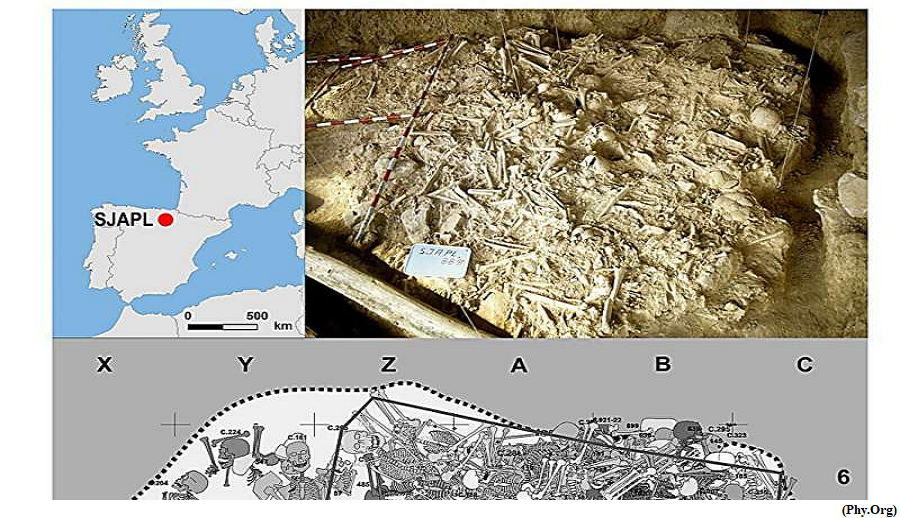Larger scale warfare may have occurred 1,000 years earlier (GS Paper 3, Science and Technology)

Why in news?
- A re-analysis of more than 300 sets of 5,000-year-old skeletal remains excavated from a site in Spain suggests that many of the individuals may have been casualties of the earliest period of warfare in Europe, occurring over 1,000 years before the previous earliest known larger-scale conflict in the region.
Details:
- The study indicates that both the number of injured individuals and the disproportionately high percentage of males affected suggest that the injuries resulted from a period of conflict, potentially lasting at least months.
- Conflict during the European Neolithic period (about 9,000 to 4,000 years ago) remains poorly understood.
Key Highlights:
- In recent study, researchers from Universidad de Valladolid, Valladolid, Spain and others re-examined the skeletal remains of 338 individuals for evidence of healed and unhealed injuries.
- All the remains were from a single mass burial site in a shallow cave in the Rioja Alavesa region of northern Spain, radiocarbon dated to between 5,400 and 5,000 years ago.
- Fifty-two flint arrowheads had also been discovered at the same site, with previous research finding that 36 of these had minor damage associated with hitting a target.
- They found that 23.1% of the individuals had skeletal injuries, with 10.1% having unhealed injuries, substantially higher than estimated injury rates for the time (7-17% and 2-5%, respectively).
- They also found that 74.1% of the unhealed injuries and 70.0% of the healed injuries had occurred in adolescent or adult males, a significantly higher rate than in females, and a difference not seen in other European Neolithic mass-fatality sites.
Background:
- Previous research has suggested that conflicts consisted of short raids lasting no more than a few days and involving small groups of up to 20-30 individuals, and it was therefore assumed that early societies lacked the logistical capabilities to support longer, larger-scale conflicts.
- The earliest such conflict in Europe was previously thought to have occurred during the Bronze Age (about 4,000 to 2,800 years ago).
Status of Kavach installations
(GS Paper 3, Science and Technology)
Why in news?
- The recent deadly collision between two passenger trains in southern India’s Vizianagaram district in Andhra Pradesh could have been averted if Traffic Collision Avoidance Systems (TCAS) were in place.
- The indigenously developed TCAS called ‘Kavach,’ was not installed on the route where the Visakhapatnam-Palasa and Visakhapatnam-Rayagada trains collided.

What is TCAS - Kavach?
- Kavach is a cab signalling train control system with anti-collision features. It was developed over a period of 10 years, starting in 2012, by the Indian Railways Research Designs and Standards Organisation (RDSO).
- Kavach is designed to give out warnings to the loco pilot in case he does not notice the ‘red signal,’ and instead of stopping, is going to overshoot the signal.
- After giving warnings on the locopilot’s display, if the pilot does not slow down below 15 kilometres per hour, the Kavach system automatically applies brakes to bring the train to a halt.
How is the Kavach system deployed?
- In the Kavach set-up, the railway stations along the route where this tech is sanctioned to be deployed are provided with three components.
- Radio Frequency Identification (RFID) technology in the tracks. RFID tech uses radio waves to identify people or objects. It uses electromagnetic fields to automatically identify and read information contained in a wireless device from a distance without making physical contact or requiring a line of sight.
- The locomotive, which is the driver’s cabin, is provided with RFID readers, computer, and brake interface equipment.
- The radio infrastructure which are towers and modems are installed at railway stations.
How does Kavach infrastructure work?
- The three components of Kavach on rail tracks, locomotives and at railway stations are communicating with each other to monitor train movements, and transmit signals ahead to locomotives. Their function is not affected by visual interferences like hilly geography or haze.
- There is direct loco-to-loco communication and information regarding location and track IDs are exchanged, in case it is noted that both trains are on the same line.
- The locomotives have antennas which communicate with towers on railway stations and display warnings to the driver on his monitor.
How much does the Kavach system cost?
- Deploying Kavach costs ₹50 lakh per kilometre for the Indian Railways.
- Experts say present coverage for Kavach is only 1,500 km and at this rate, it may take many years to ensure Kavach even on high-density routes as Railways has a total route length of 68,000 kms.
- Current Kavach coverage includes the 1,400 km stretch in South Central Railway and 200 to 250 km routes from Delhi to Mumbai and Delhi to Kolkata where it is still under testing in patches, installed in 100 kms here and there, not in continuous sections and not operational.
- Currently the Indian Railways has allotted ₹4,000 crore under the Signalling and Telecom budget head which includes ₹2,000 crore under the Rashtriya Rail Sanraksha Kosh (RRSK) fund which implements Kavach.



